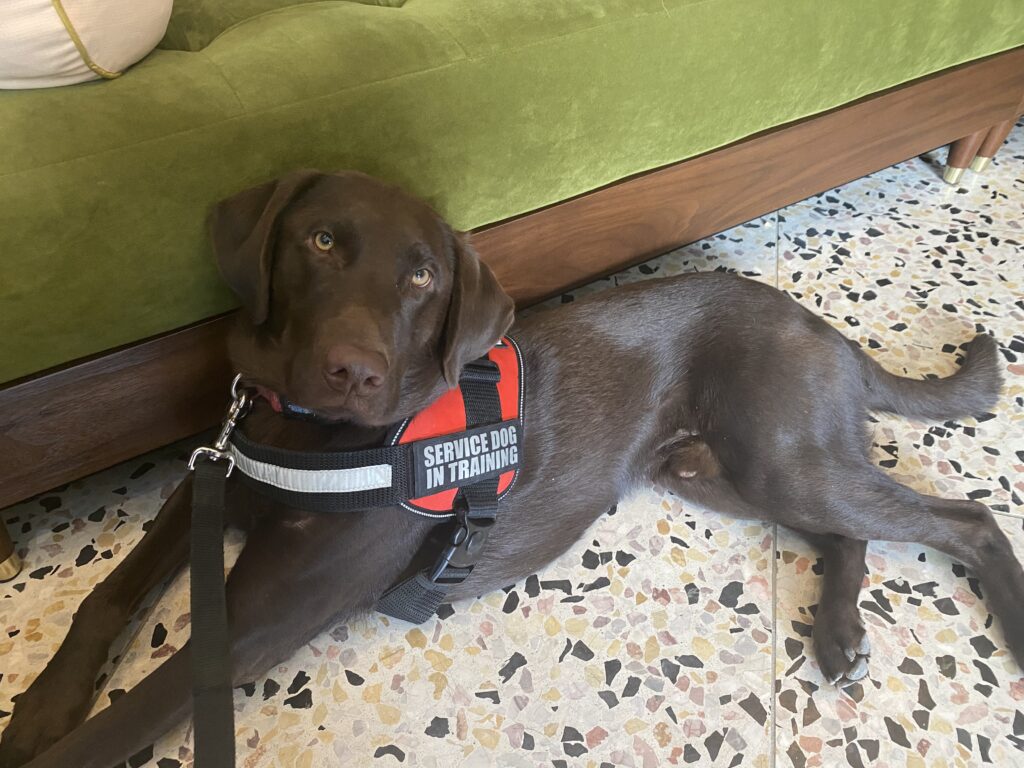Okay, so… picture this: your dog is truly relaxed. Not just holding a stay or looking obedient on the outside, but actually calm on the inside.
We’re talking soft eyes, loose muscles, steady breathing — even in a busy coffee shop, at the airport, or when guests come over.
Sound like a dream?
In this episode of The Collab Dog Training Podcast, I’m diving into one of the most powerful, underrated skills you can teach your service dog: true, deep relaxation.
And the best part? You can start today, with just a few simple tools and a willingness to slow down.
Why Relaxation Matters More Than Obedience
Let’s get one thing straight: relaxation is not obedience.
It’s not about your dog holding a “down” while frozen in tension. It’s about helping their nervous system stay regulated — even when little things in the environment might usually trigger them.
When we reward relaxation, we’re reinforcing the parasympathetic nervous system — the body’s natural “rest and digest” mode. And here’s what that actually does for your dog:
- ✅ Speeds up recovery after stress
- ✅ Builds resilience to change
- ✅ Supports confidence in public spaces
- ✅ Helps them think clearly and make good choices
Honestly? This is foundational for everything from public access work to vet visits, airports, and just everyday life.
What You’ll Need to Get Started
This training is simple but powerful. Here’s what you’ll want to gather:
- A mat or towel for your dog to settle on (I love a shower mat — more on that in a second)
- 10 to 20 pea-sized treats
- A quiet space with minimal distractions
- An optional leash if your dog is young or excitable
Your only job during this practice?
Reward signs of relaxation, not stillness.
Look for:
- Soft eyes
- Relaxed jaw
- Loose body
- Calm breathing
Why I Recommend a Shower Mat (Yes, Seriously)
I know it might sound funny, but I love using shower mats for this kind of training. Here’s why:
- They’re lightweight, rollable, and portable
- You can use them on tile, carpet, concrete, or grass
- They’re just big enough to give your dog a clear visual cue without taking up space
- Most importantly… they’re easy to generalize
We want your dog to learn:
“Wherever this mat goes, I can relax.”
Whether you’re in a crowded airport gate, a friend’s living room, or your local coffee shop, that familiar mat becomes their portable “settle zone.”
Try This Mini Relaxation Protocol
Think of this like emotional strength training — helping your dog regulate from the inside out.
| Step | Action | Watch For |
|---|---|---|
| 1 | Ask for a sit or down | Choose what’s comfortable |
| 2 | Watch quietly | Reward soft eyes, relaxed breathing |
| 3 | Wait 5 seconds | Reward again if still relaxed |
| 4 | Step back slowly, then return | Reward calm behavior |
| 5 | Light clap | Pause, reward if they stay soft |
| 6 | Two slow steps sideways | Reward again |
| 7 | Sit quietly for 10 seconds | Reward calmness |
| 8 | Say “Free!” and toss a treat | End on a happy note! 🎉 |
Key Mindset Shifts as You Train
This isn’t about rushing or doing it “right.”
Here’s what I want you to remember:
- If it feels easy — great! That means you’re in the sweet spot.
- If your dog gets up — that’s feedback, not failure.
It just means that step might be too hard right now. - If you’re getting frustrated — pause.
Frustration is your cue to simplify.
Let’s say your dog struggles when you step back.
No problem: try just shifting your weight, or tapping your foot first. This is called splitting criteria, and it’s a game-changer in training.
Remember, we’re not forcing dogs to stay still… we’re helping them choose calmness. At their own pace. With trust, clarity, and support.
Ready for Real-World Practice?
If you want more help building calm, confident behavior in public spaces…
🎧 Check out my Airport Settle Series —
You’ll get daily task lists, real-world practice tips, and a private podcast you can listen to while you train.
👉 Get all the details at collabdogtraining.com/courses
Listen to the Full Episode
This post just scratches the surface. In the full episode, I talk through:
- Why dogs struggle with regulation
- What this protocol looks like in action
- How to troubleshoot common roadblocks
🎙️ Listen now on your favorite podcast app
Final Thoughts
Thanks so much for being here — and for choosing to train with love, science, and snacks.
If you found this helpful, I’d love it if you subscribed, left a review, or shared the episode with a friend.
And remember:
Your dog’s calm confidence starts with connection — not control. 💛
